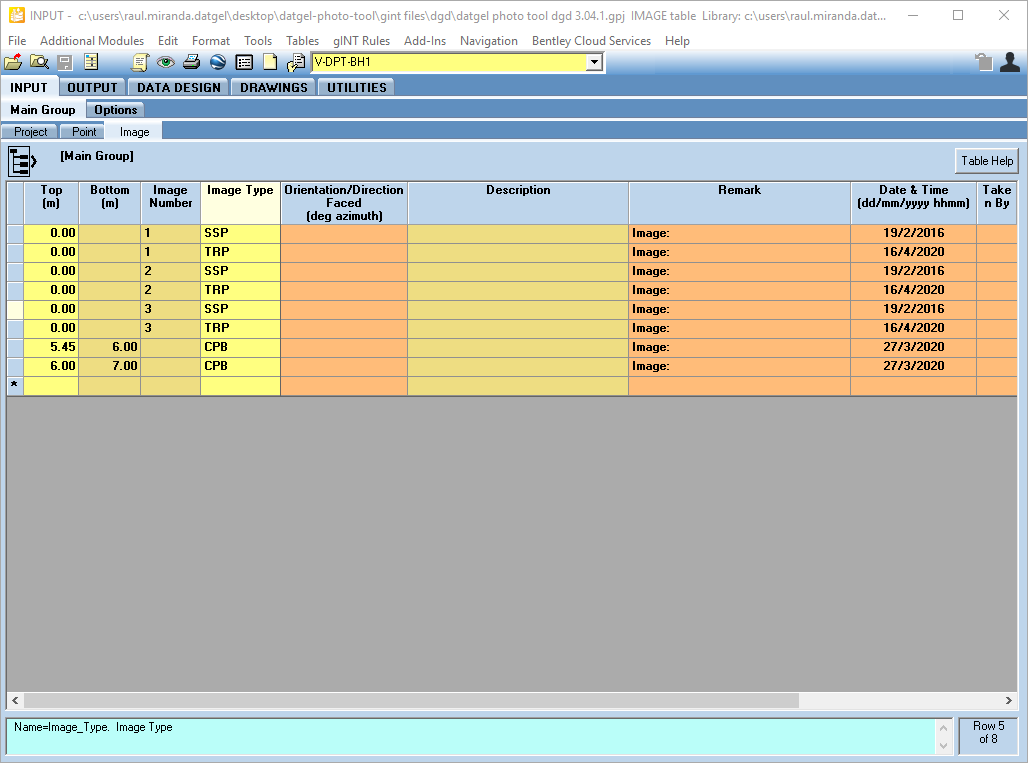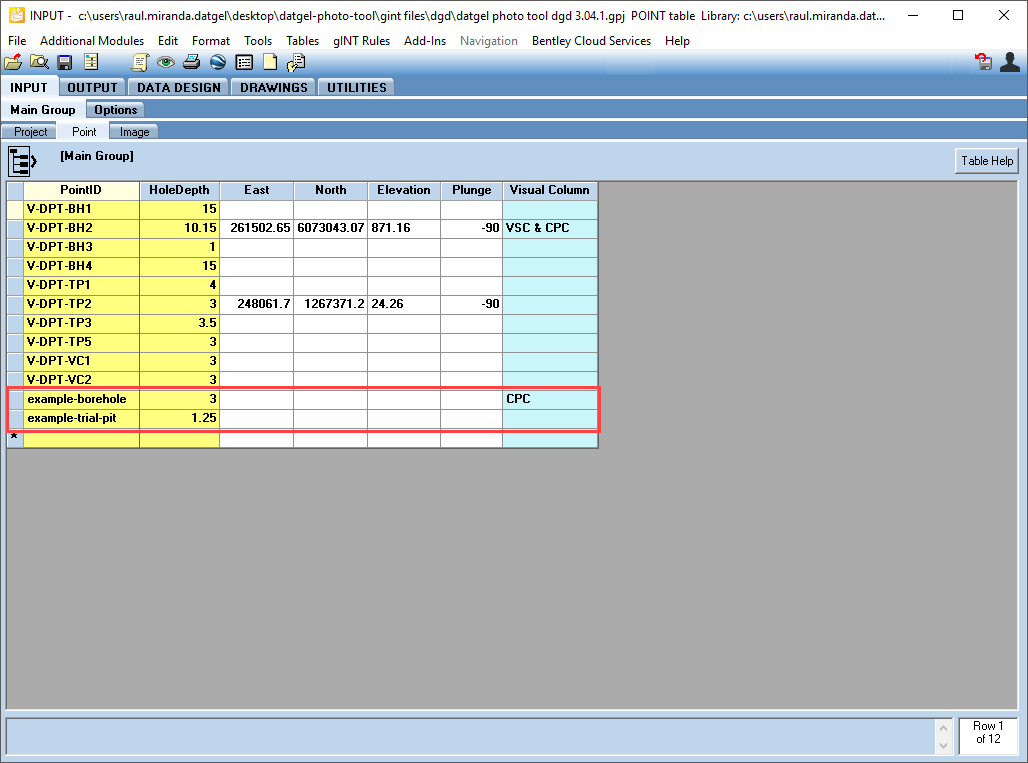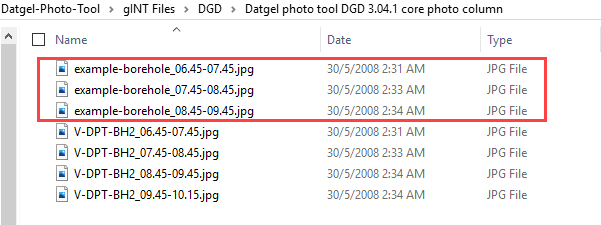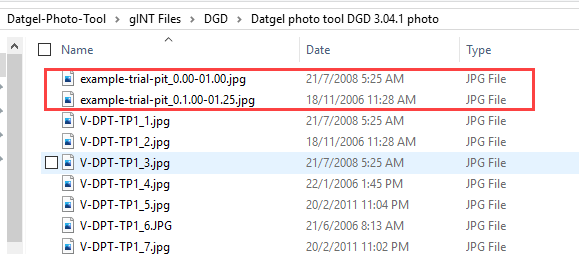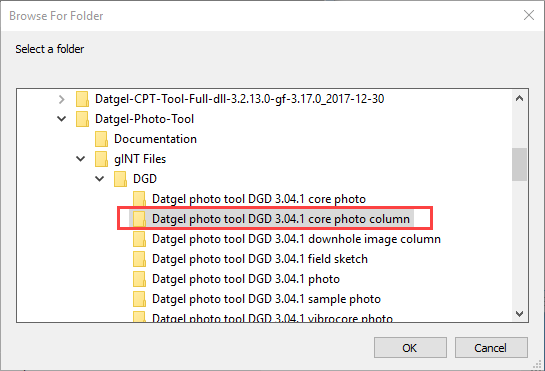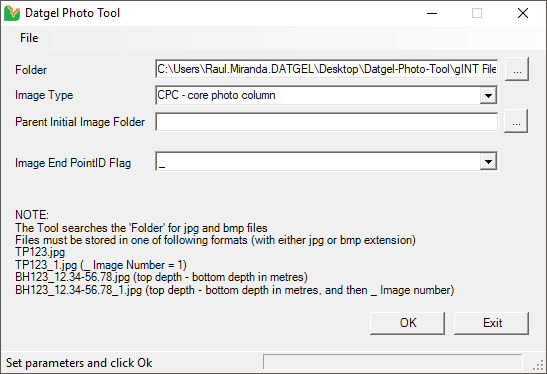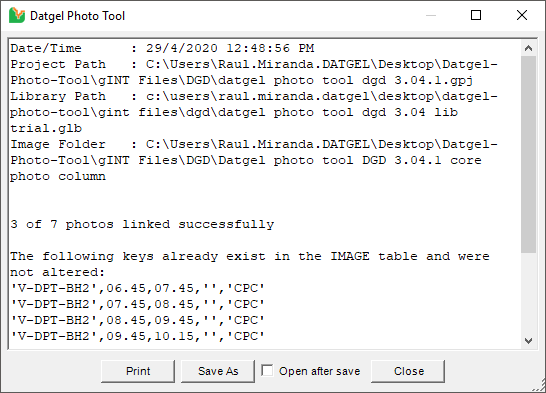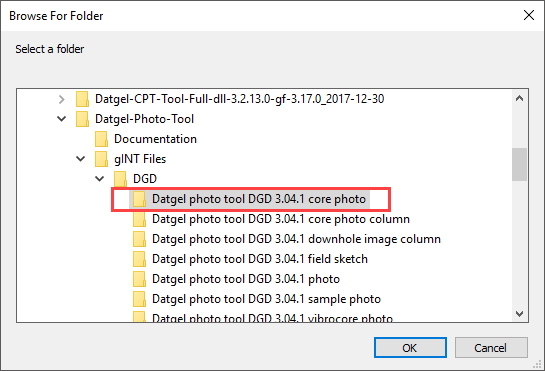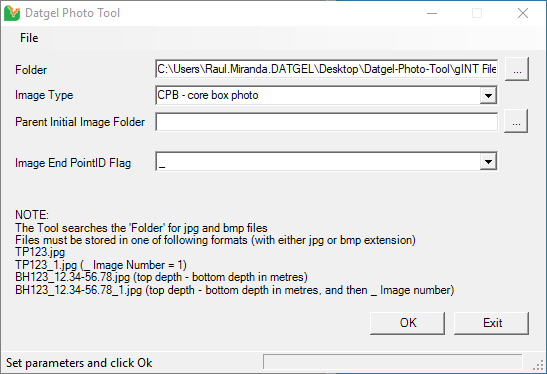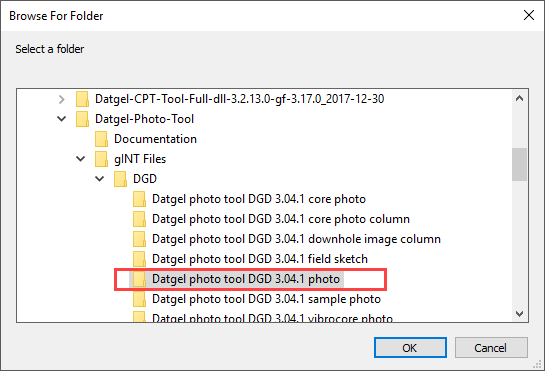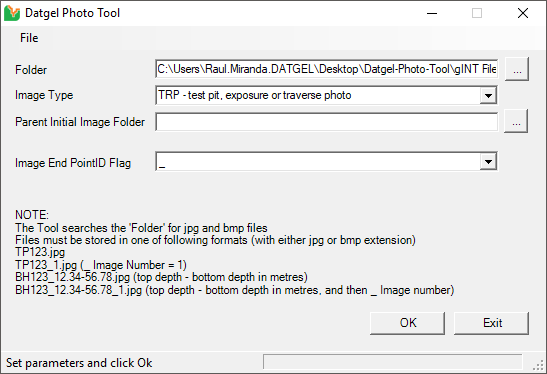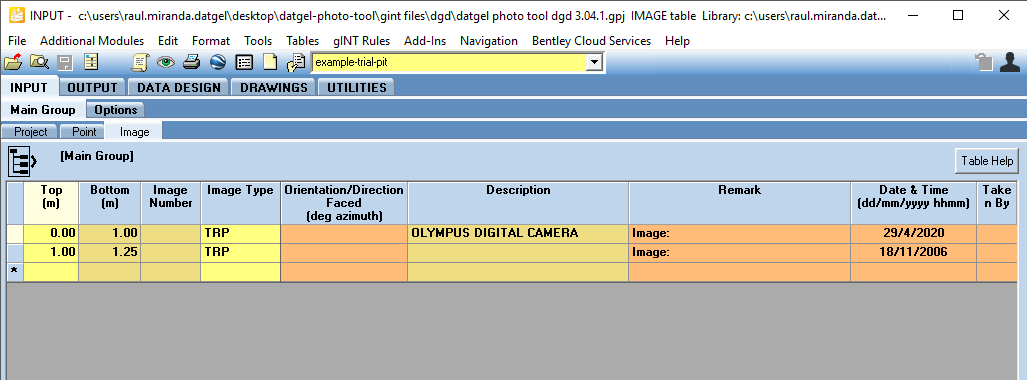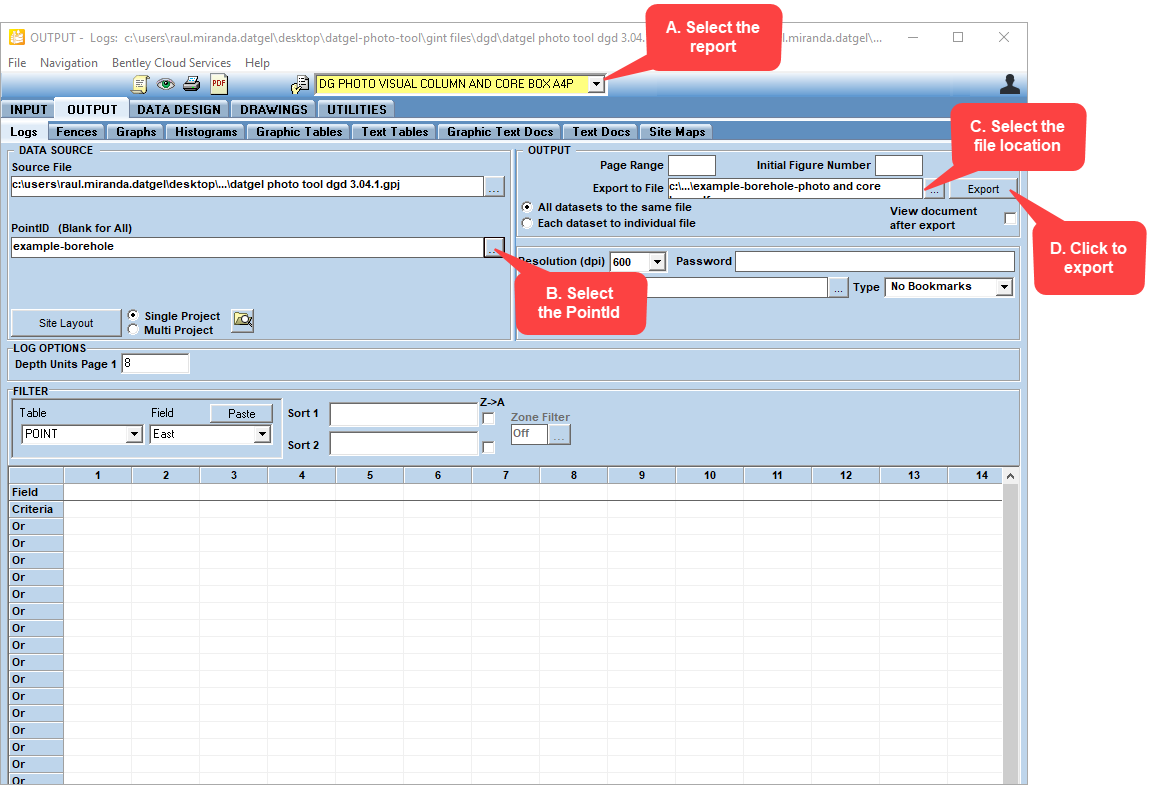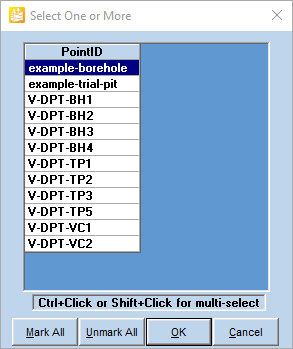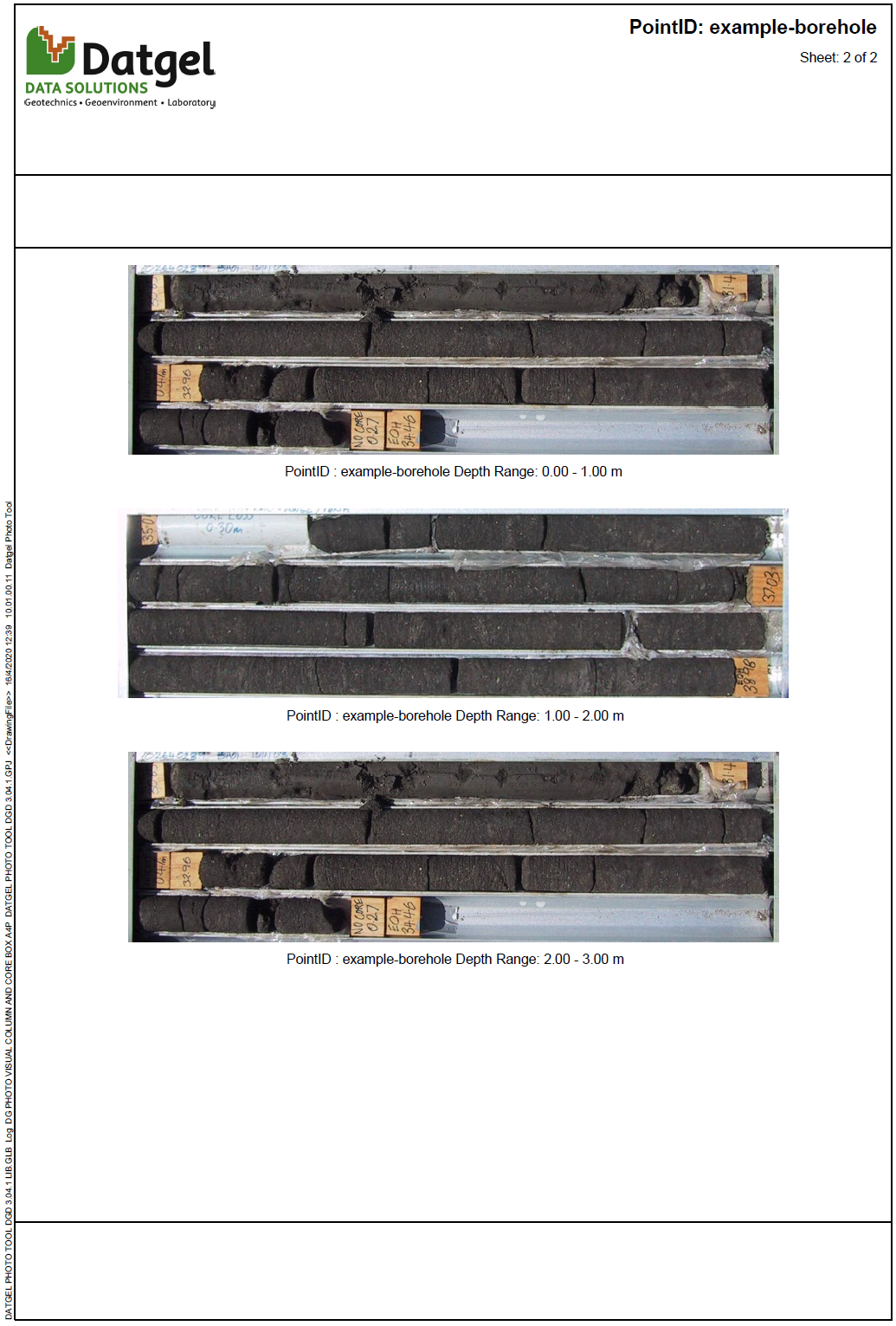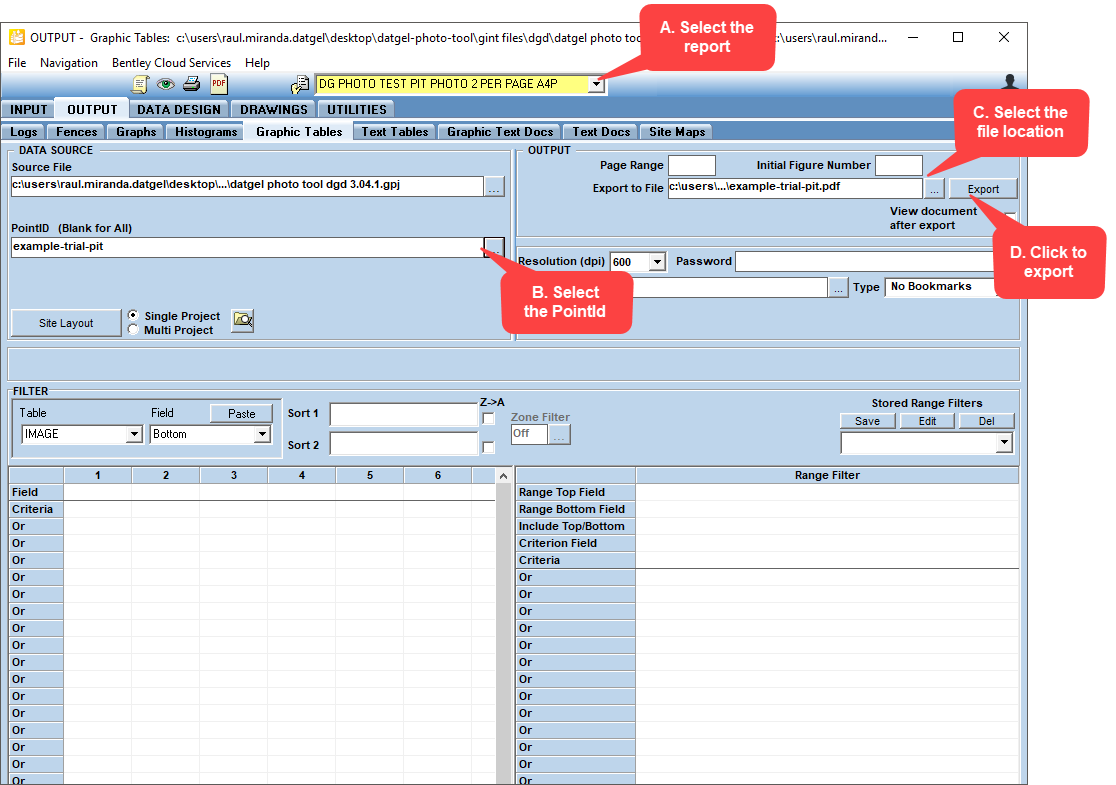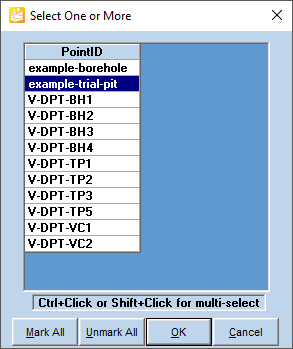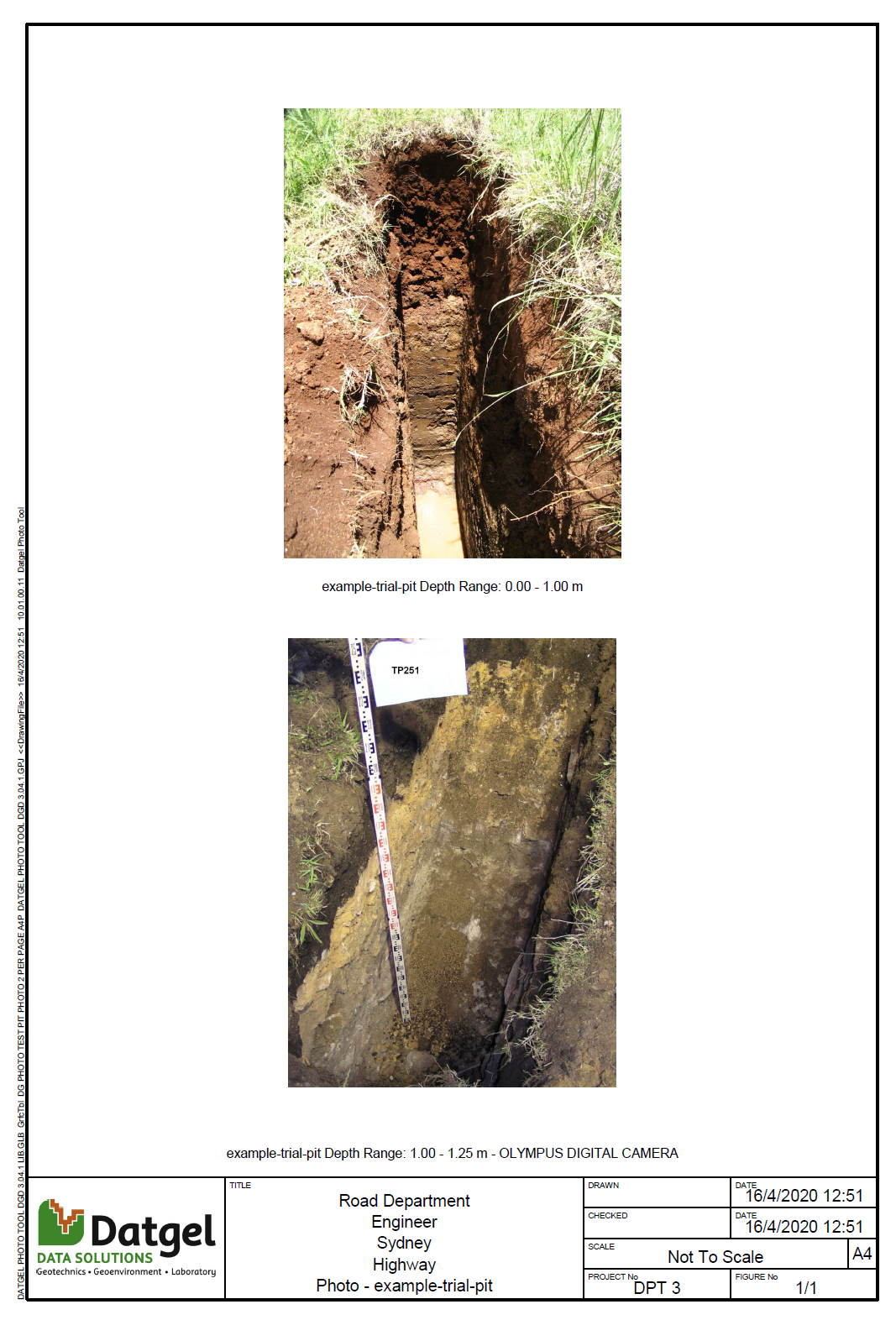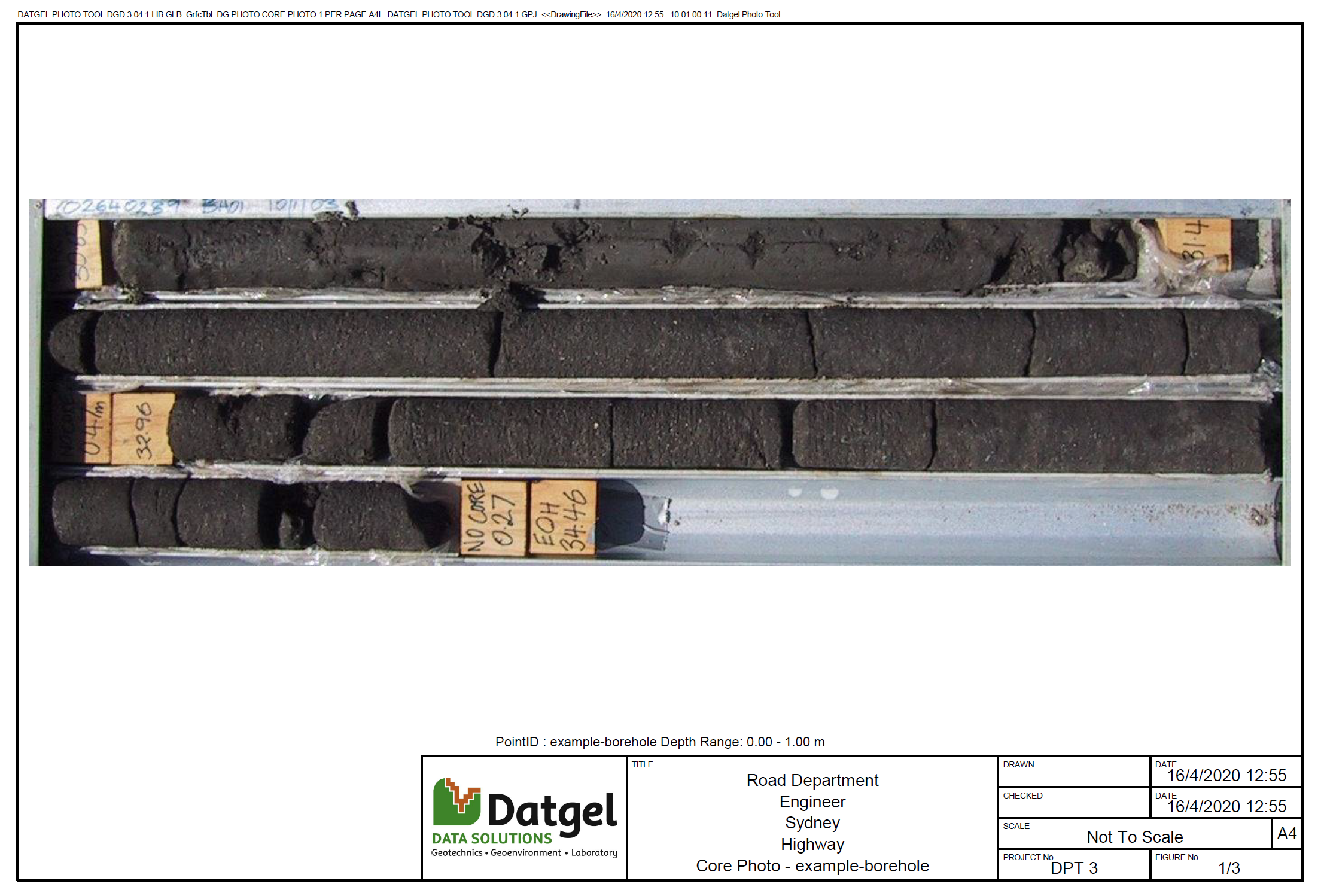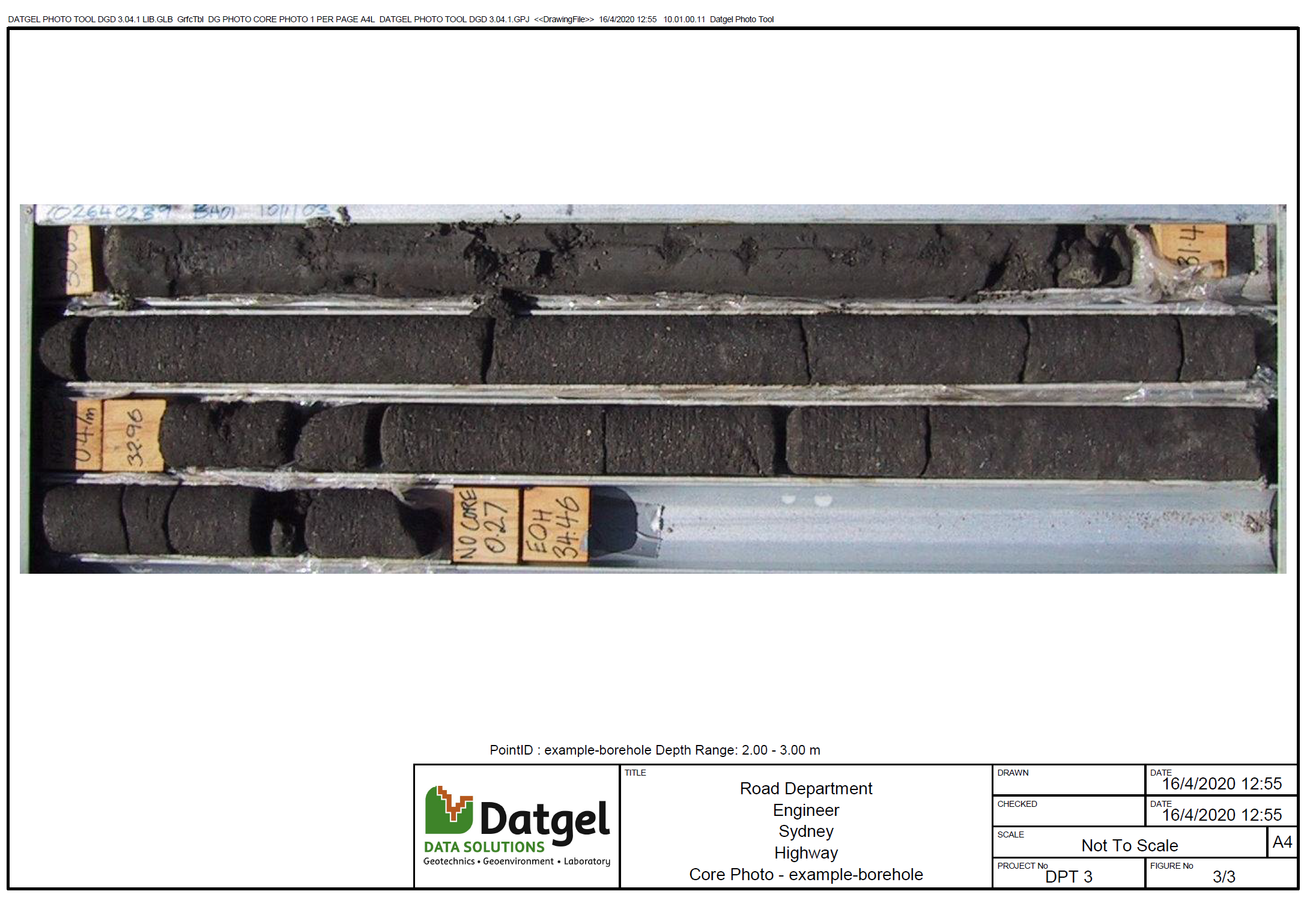Quick Start Guide
Overview
This page guides you through the setup and explains basic use of the Photo Tool.
gINT
gINT must be installed and licensed on your computer to use the Photo Tool. gINT Professional or Professional Plus are required to fully utilize this product.
Datgel Photo Tool Download
Download the Photo Tool package and Datgel Toolbox Installer:
- Full version: https://www.datgel.com/customer/downloadableproducts
- Trial version: https://www.datgel.com/trial-software
Install Datgel Toolbox
Before Installation
A few basic preparations can help ensure an effortless installation.
- Make sure that the computer where you plan to install the program meets the minimum hardware and software requirements.
- Connect your PC to Internet before installation (the process may need a working Internet connection).
- The Datgel Toolbox program requires that the Microsoft .NET 4.8 framework is installed on the PC prior to the installation of the Tool. If your PC does not have this, then it will be automatically downloaded and installed during the Tool installation process.
- Log into the PC with Administrator privileges before starting installation.
- It is recommended that you exit out of other applications that maybe running on your PC.
- Close gINT before you start installation.
Installation
- Run the installer, typically named Datgel.Toolbox.20##.#.#_YYYY-MM-DDTHHmmss.exe.
- When you come to the Components screen, be sure to select this product, or you can simply install all Components.
- The gINT*.exe.config files for gINT versions V8i and 10..# are edited by Datgel software during installation.
Datgel Licensing
Package Content
The Download .zip folder contains all you need to install and evaluate the Datgel Photo Tool. The content is:
- Documentation folder includes:
- Example reports
- EULA
- Links to the product online user guide
- Link to email to support.
- gINT Files folder includes:
- "dpt X.XX.X lib trial.glb" or "dpt X.XX.X lib.glb" (gINT library file)
- "dpt X.XX.X.gpj" (gINT project file)
- "dpt X.XX.X.gdt" (gINT data template)
- Sub-folders for each photo type:
- "dpt x.xx.x core photo"
- "dpt x.xx.x coro photo column"
- "dpt x.xx.x downhole image column"
- "dpt x.xx.x field sketch"
- "dpt x.xx.x photo"
- "dpt x.xx.x sample photo"
- "dpt x.xx.x vibrocorer photo"
- "dpt x.xx.x visual column"
Unzip and copy the content of the folder to your local computer.
Using the Tool
Open gINT
- Start gINT
- When you open gINT if it asked for a library, then browse to the extracted .zip folder and select the library file (.glb). Otherwise after gINT opens select File > Change Library, and browse to the aforementioned library. Note: the library is locked for the Trial version.
- Select File > Open Project. Browse to the downloaded .zip folder and select the project file (.gpj)
Review existing example data
The gINT files included in the package contain example data that covers all type of reports included in the Tool.
Main Group | Point table stores the general information related to the Borehole (Hole depth, coordinates, elevation, etc). Each row is a borehole.
Main Group | Image table stores the image meta data for each Borehole. You can select the borehole by using the yellow drop-down list.
Options | Image Description table stores the image description configuration.
Naming the images and linking them to the boreholes using the Photo Tool Add-In
First you need to create a new PointID in the database. In this tutorial the example gINT files included in the tool are used.
- Go to POINT table and create 2 new PointIDs, as shown in the following screenshot. New PointIDs are called example-borehole and example-trial-pit. Select CPC on the Visual Column for the example-borehole.
- Then, we need to add the images to the folders.
- From the files included in the package you have downloaded, browse to the folder gINT Files\dpt 3.04.1 core photo column. In this folder we will add the Core Photo Column. You can add your own files or copy the existing ones and rename them to:
- example-borehole_00.00-01.00.jpg
- example-borehole_01.00-02.00.jpg
- example-borehole_02.00-03.00.jpg
- Now add images for the core box to the folder gINT Files\dpt 3.04.1 core photo. In this folder we will add the core box photos. You can add your own files or copy the existing ones and rename them to:
- example-borehole_00.00-01.00.jpg
- example-borehole_01.00-02.00.jpg
- example-borehole_02.00-03.00.jpg
- Now we will add images for the trial pit to the folder gINT Files\dpt 3.04.1 photo. In this folder we will add the trial pit photos. You can add your own files or copy the existing ones and rename them to:
- example-trial-pit_00.00-01.00.jpg
- example-trial-pit_01.00-01.25.jpg
- From the files included in the package you have downloaded, browse to the folder gINT Files\dpt 3.04.1 core photo column. In this folder we will add the Core Photo Column. You can add your own files or copy the existing ones and rename them to:
- Once we have all images in the correct folder, we can run the add-in to link them to each borehole.
- First we will link the Core Photo Column images:
- Go to Add-Ins > Datgel Photo Tool > Datgel Photo Tool.
- Select the Folder: In the Add-in form, click on the button and browse to the folder where the images are stored.
- Select the Image Type: from the drop-down list, select CPC - core photo column
At this point your add-in form should look like the following image: - Click OK.
- New window will open with the summary and result of the link process.
- Click Close on the result window.
- You could close the form and view the data you just added. Or keep it open to do the next linking operations.
- Now we will link the Core Photo Images:
- Select the Folder: In the Add-in form, click on the button and browse to the folder where the images are stored.
- Select the Image Type: from the drop-down list, select CPB - core box photo
At this point your add-in form should look like the following image: - Click OK.
- Click Close on the result window.
- Select the Folder: In the Add-in form, click on the button and browse to the folder where the images are stored.
- Now we will link the Trial Pit images:
- Select the Folder: In the Add-in form, click on the button and browse to the folder where the images are stored.
- Select the Image Type: from the drop-down list, select TRP - test pit, exposure or traverse photo
At this point your add-in form should look like the following image: - Click OK.
- Click Close on the result window.
- Click Exit on the Datgel Photo Tool form.
- Select the Folder: In the Add-in form, click on the button and browse to the folder where the images are stored.
- You can review the linked images in the Image table:
- First we will link the Core Photo Column images:
Output example
This section explains how to print reports using the reports included in the library.
Log report
The following example explains how to output the point example-borehole core and box photo log report.
- First go to OUTPUT | Logs
- Select the PHOTO VISUAL COLUMN AND CORE BOX A4P report from the yellow drop-down list.
- Select the desired PointIDs using the KeySet picker.
- review the report.
You may add columns to these pages (e.g. soil description, samples, in situ tests, etc).
The following example explains how to output the Point example-trial-pit trial pit photo report.
- Go to OUTPUT | Graphic Tables
- Select the PHOTO TEST PIT 2 PER PAGE A4P report from the yellow drop-down list.
- Select the desired PointIDs using the KeySet picker.
- review the report.
- Alternatively, click the button to preview the report. You can review next page using the yellow drop-down list or press F6 button.
Graphic Table Core Photo
The following example explains how to output the Point borehole-example core box photo report.
- First, go to OUTPUT | Graphic Tables
- Select the PHOTO CORE 1 PER PAGE A4L report from the yellow drop-down list.
- Select the desired PointIDs using the KeySet picker.
- Click on the button and choose the name for the new pdf document. Choose the location and click Save. Choose resolution 600 dpi.
- Click Export.review the report.
- Alternatively, click the button to preview the report. You can review next page using the yellow drop-down list or press F6 button.
